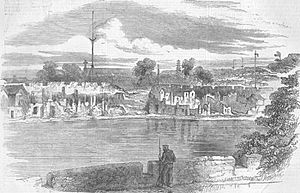Battle of Canton (1856) facts for kids
Quick facts for kids Battle of Canton |
|||||||
|---|---|---|---|---|---|---|---|
| Part of the Second Opium War | |||||||
 Ruined walls of Canton from the Dutch Folly Fort |
|||||||
|
|||||||
| Belligerents | |||||||
| Commanders and leaders | |||||||
| Michael Seymour | Ye Mingchen | ||||||
| Strength | |||||||
| 9 ships 580 |
unknown | ||||||
| Casualties and losses | |||||||
| 2 killed 12 wounded |
18–19 killed & wounded | ||||||
The Battle of Canton was a fight between British and Chinese forces. It happened in the city of Canton (now called Guangzhou) in China. The battle took place from October 23 to November 5, 1856. It was an important part of the Second Opium War.
Contents
Starting the Battle: Forts and Rivers
On October 23, 1856, British ships began their attack. They aimed for four forts known as the Barrier Forts on the Pearl River. Two British ships, the Coromandel and the Barracouta, quickly took control of these forts. The first shot of the war was fired from the Coromandel.
Rear-Admiral Michael Seymour, who led the British forces, reported that no British soldiers were hurt. A few Chinese soldiers were killed because they tried to fight back. After this, Seymour moved his ships towards Canton. He sent other ships to make sure the river was safe for travel. These ships took over more forts without any fighting.
Taking Key Positions
The next morning, British forces continued their advance. They took control of the Dutch Folly Fort and the Bird's Nest Fort. These forts were important for controlling the river near the city. They also captured two forts on Shamian Island.
The British made the captured guns useless so they could not be used against them. A group of Royal Marines landed to protect the trading areas, called factories. More sailors and marines joined them later. They set up guard posts and barricades in the streets to prevent surprise attacks.
First Clashes and a Day of Rest
On October 25, Chinese forces attacked the British guards. The Marines fought back and pushed them away. Fourteen Chinese soldiers were killed or wounded in this clash. The next day, October 26, was a Sunday. The British stopped their operations for a "day of rest."
Attacking the City Walls
On October 27, the British resumed their attack. A ship called the Encounter began firing at Governor Ye Mingchen's office, known as the yamen. Another ship, the Barracouta, shelled Chinese troops on the hills behind the city. The British warned people living nearby to leave their homes for safety.
Breaching the Walls
On October 28, the British continued their attack from the Dutch Folly Fort. They set up more guns there. Their shelling caused a large fire in the city, which helped clear a path to the city walls. This made it easier for them to attack.
The next morning, the British started firing earlier than expected. This was because the Chinese had placed more guns opposite the Dutch Folly. Around 2 PM, about 400 marines and sailors attacked the city wall. They blew up one of the gates and entered the city. They checked the governor's house and then returned to their ships by sunset.
Admiral Seymour reported that the Chinese troops did not fight much. They only fired a few shots from the streets and houses. During this part of the battle, two British soldiers were killed and twelve were wounded.
Aftermath of the Battle
After the British entered the city, Governor Ye Mingchen still refused to give in. So, the British continued their attack on October 30. They kept firing at the city walls to maintain the breach they had made.
The shelling continued every day until November 5. The British ships and the Dutch Folly Fort targeted government buildings and other forts. Chinese war junks (ships) gathered near the French Folly Fort for protection. Because of this, the British captured the French Folly Fort on November 6.
Images for kids




